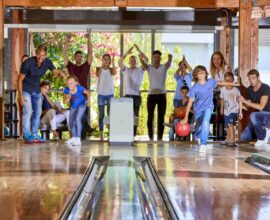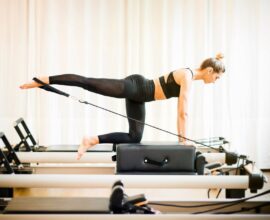Paddle tennis: rules for you to play the game of the moment
Padel tennis: characteristics of a dynamic sport full of enthusiasm
Padel tennis is similar to tennis, squash or racquetball. It’s the ideal sport for anyone wanting to stay in shape and have fun with their friends.
This discipline makes use of a racquet and a ball but it’s the field that distinguishes it: a 10 metre wide and 20-metre long rectangle with a net in the middle and four walls enclosing the area.
The central part of the net is 88 centimetres tall and gets higher at the sides to a maximum of 92 centimetres. The field is half the size of a tennis court.
On the sides of the field, parallel to the net and 6,95 metres from it, are the serving lines called ‘central service line’ and divide the area into two equal parts.
There is a fence along the entire perimeter of the court and there are some areas made of materials where the ball can bounce off and some metallic areas which if bounced off by the ball are considered an irregular throw. The baseline walls are 4 metres tall of which the initial three metres from the ground are made of opaque or transparent materials such as glass, bricks or cement and the last metre is made of metal.
Along the length of the court, there can be two kinds of wall. Let’s look into their characteristics:
First option: the side can be made with a 3 metre tall and 2-metre wide “step” structure and 2 metres tall and 2-metre wide structure on the other side. To complete the enclosure there is a 3-metre high metal net of 16 metres in length in the central area and a 4 metre high net in the last 2 metres.
Second option: in this case, the hight of the metal net in the 16 metres of the central area is always of 4 metres.
There can be one or two entrances with or without a door in the central part of the sidewall in the metal netting. If the entrances have doors the handles must be only on the outside.
Let’s discover a little more about the origin of Padel tennis and learn the basic rules of the game.
Padel tennis: rules of the sport which conquered Forte Village Resort
Padel tennis was invented by American reverend Frank Beal in 1898 who decided to name it after the hard flat racquet used to play the game, a padel racquet.
In 1915 Beal had permission to build a padel tennis court in Washington Square Park where the first match took place in 1922. One year later the United States padel Tennis Association was inaugurated and in 1941 over 500 American cities played Padel tennis.
It’s a sphaeristic sport played in many countries, particularly in Argentina wherein 1993 there where already 35.000 fields and 4.500.000 players.
The first courts in Italy were built in 1991, some in Bologna but mostly in Rome where there are almost 100 courts. In 2016 also in the village of Lama, Taranto, the first facility was built.
The sport is played by women and men of all ages, it’s a simple a and dynamic sport which is good for psychophysical health and helps stay in shape by toning arm muscles, gluteus, it helps improve physical resistance, muscle power and the production of endorphins which contrast anxiety and stress.
Padel tennis can be played in evenly or mixed, with a solid flat racquet with holes and a ball with many pressurisation levels to help the bounce just like a tennis ball.
The score is calculated like in tennis (points, game and set, tie break and benefits), the main rules are not many but of utter importance.
The Padel tennis rules consist of:
The walls at the extremities of the baseline are part of the game area, meaning if the ball bounces off the wall it can be hit by a racquet and the game continues.
The service is made diagonally, from down to up and the ball must bounce on the court before it’s sent back.
The passages must be alternate starting from the far back right side to the serving area on the left side of who is receiving and then sent from the far back left side.
The ball mustn’t directly touch the sides and the walls of the adversaries area or the metallic netting, it also cannot bounce twice on the ground.
Except for when the ball is served, the players may hit the ball volée. It’s also possible to bounce the ball off the walls of their court to pass it in the direction of their adversaries.
Like in tennis, the ball must be hit before the second bounce on the ground.
A point is made every time the ball hits a wall before bouncing on the ground, when it bounces off the metallic grid, when it bounces twice on the ground or when sent back from a player it bounces on the floor of the opposites field going beyond the limitation of the area and hits a foreign object or bounces twice on the adversaries field.
A player may hit the ball and make it bounce on the adversaries field so that after it hits the ground the ball exits the court’s fence. The players can also exit the field and hit the ball if it hasn’t bounced on the floor a second time.
A player may send the ball to any wall (baseline and lateral) of their side of the court and make so that it passes to the other side of the central net towards the other team’s court. The ball bouncing in a corner formed by the walls creating the U and the floor is considered a good ball.
Here are seven reasons why a team could lose a point:
- The ball bounces twice on the ground before sent back to the other side.
- A player hits the ball before it has come over the net and is in their side of the court. This is the “rule of invasion”.
- A player hits the ball and it touches either the net or floor on their side.
- The ball during a match touches the player, except for their racquet.
- A player sends the ball back hitting the ball in flight toward any of the adversaries wall, the metallic netting or external elements: the netting, the supporting poles, the central strap or the band and it then enters the adversaries game area.
- The player touches or hits the ball more than once while sending the ball back.
- Two players hit the ball simultaneously or consecutively.
Which are best Padel tennis courts in Italy?
Among the best Padel tennis courts to visit there is the one at Forte Village, the multi-prized resort in Santa Margherita di Pula in Sardinia, where one can have a personal instructor or play freely with friends.
Forte Village is truly a sports resort and Padel tennis has been added to the wide variety of activities connected to sport: soccer, go-kart, also water sports and the ancient art of fencing, there truly is something for everyone.
Would you like to learn how to play Padel Tennis and have a dream-like vacation in a true paradise? Discover Forte Village Resort.






